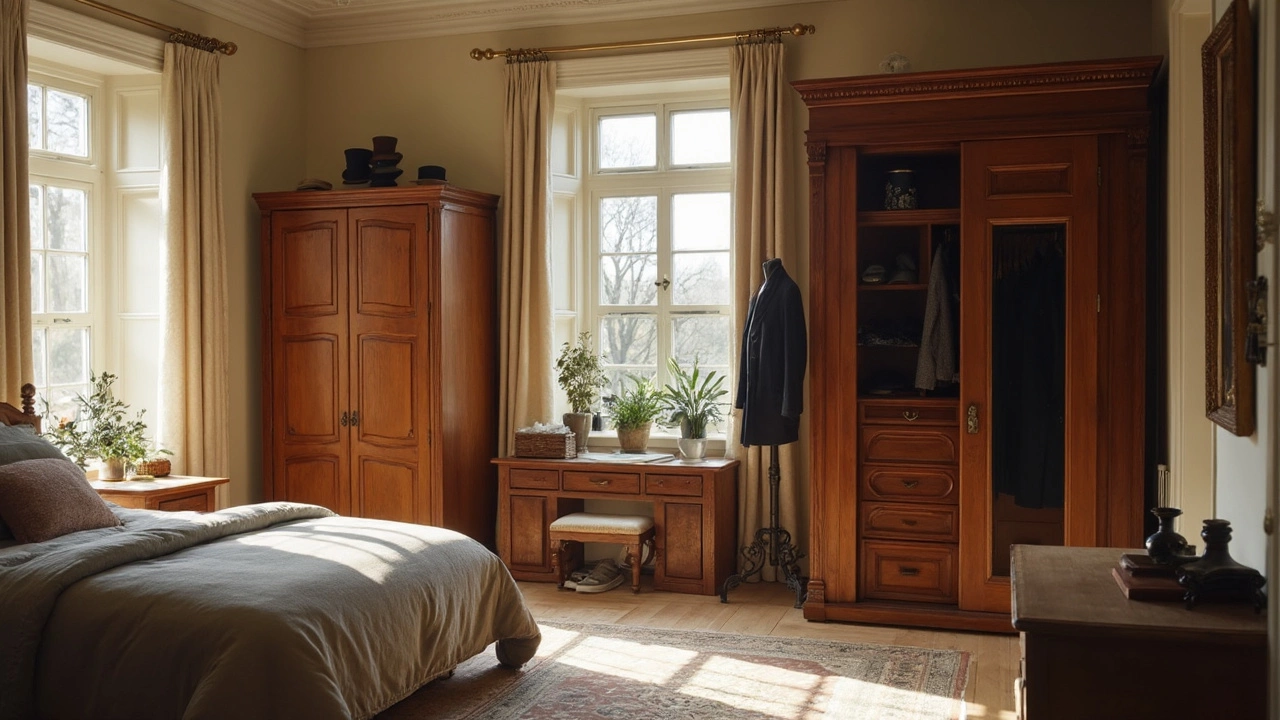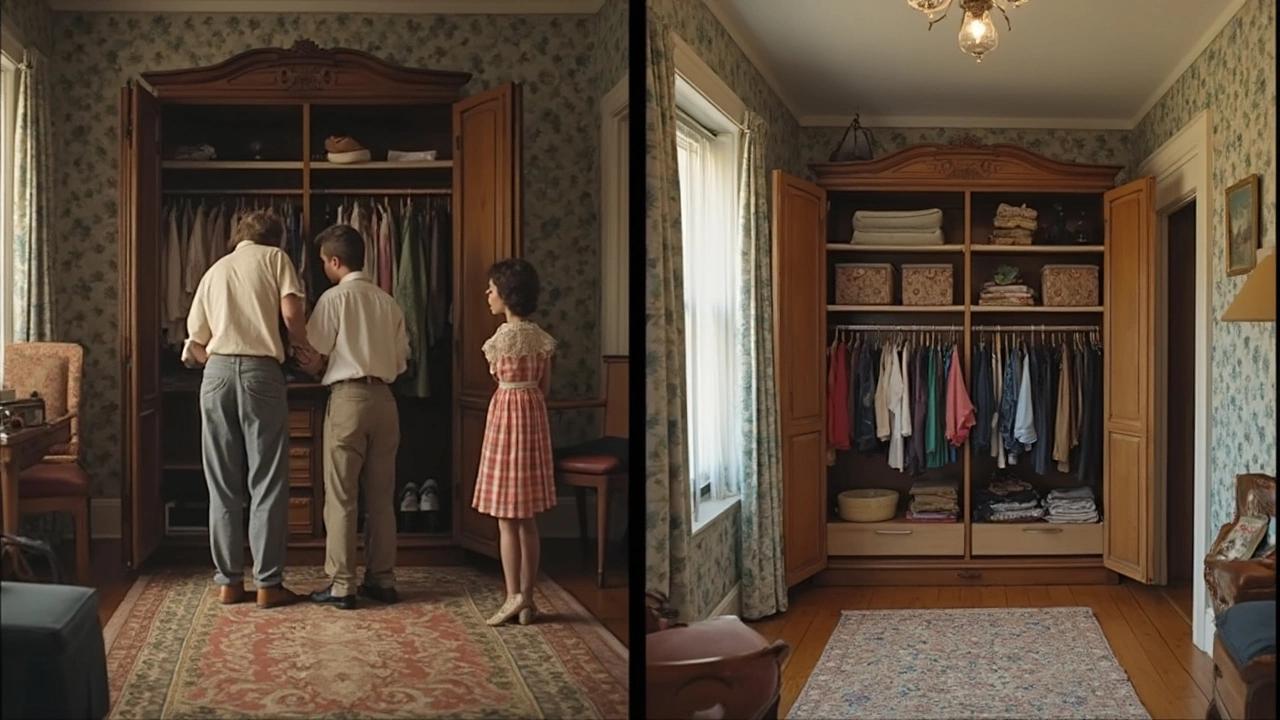
If you ask someone in America where their wardrobe is, don’t be surprised if they just point at a closet. The word 'wardrobe' isn’t common in everyday American talk. Here, it’s almost always 'closet.' If you walk into a bedroom in the U.S., you’ll probably see a built-in space with a door—that’s the closet, and that’s where clothes go.
This mix-up trips up a lot of people, especially if you grew up calling a big free-standing piece of furniture a wardrobe. In the U.S., when folks do use the word 'wardrobe,' it usually means the clothes themselves—not the place where you store them. If you say, 'I need a new wardrobe,' people will think you want new outfits, not a new cabinet.
Confused by what to call it when you’re shopping for furniture? Stick with 'closet' for built-in spaces and 'wardrobe' or 'armoire' for any big piece you buy to stand against the wall. But honestly, most houses or apartments in America are built with closets already, so stand-alone wardrobes aren’t all that popular here. If you do want one, you’ll probably find it sold as an 'armoire.'
In America, if you mention a wardrobe, people might just think you’re talking about your clothes. But if you say closet, they know you mean a space for storing clothes, shoes, or even extra stuff. This difference isn’t just about slang—it’s a real swap in how Americans name things.
The main reason? Closets are mostly built-in. Nearly every American bedroom comes with one—sometimes even two or more. So, when Americans talk about where their clothes go, they almost always mean their closet, not a big cabinet like a wardrobe. Meanwhile, in the UK or other countries, a wardrobe is usually a large, stand-alone piece of furniture for hanging and storing clothes.
Here’s a quick breakdown to keep it straight:
You might find some crossover in old houses or apartments, especially in big cities, where a “wardrobe” can act as a closet in rooms without a built-in one. But if you’re in a furniture store, asking for a wardrobe will usually land you in the armoire section. Want to sound local? Stick to closet when talking storage.
| Term | USA Meaning | Common Alternative |
|---|---|---|
| Closet | Built-in storage space | None (most common) |
| Wardrobe | Clothing or, rarely, a free-standing cabinet | Armoire |
So, next time you’re in the U.S. and need to store your stuff, remember: it’s almost always called a closet.
This swap between wardrobe and closet didn’t just happen overnight—there’s a story here rooted in old houses and changing lifestyles. Back in Europe, especially in England, most homes didn’t have built-in spaces for clothes. People used big free-standing cabinets called wardrobes. When British folks talked about a wardrobe, they meant that piece of furniture sitting in the bedroom.
Once folks started building homes in America, architects went another way. Instead of lugging around heavy cabinets, they just built a recessed space right into the wall and put a door on it. That’s the closet. Early American homes—especially from the late 1800s forward—started including closets as a regular feature. Americans loved the convenience, so the old wardrobe furniture never really caught on as the go-to term.
The word 'closet' actually comes from the old French word 'clos,' meaning a small, enclosed space—a far cry from today's wardrobe crashing with shoes and shirts. The shift in language happened fast once closets became normal in American houses.
If you hop across the Atlantic today, you'll still notice the difference. Walk into most British homes and you’ll see a wardrobe up against the wall, not a closet. In the U.S., it’s almost always a built-in closet, unless the house is old or you’re visiting a fancy hotel suite that calls the wardrobe an 'armoire' for style points.
| Era | England/Europe | America |
|---|---|---|
| 1700s | Wardrobe furniture | Wardrobe, sometimes chest |
| 1800s | Wardrobe dominates | Shift to closets |
| 1900s | Wardrobe still popular | Closet common in homes |
| Today | Wardrobe in use | Closet is standard |
That’s the quick rundown of why Americans say closet and not wardrobe—history just moved in another direction here.

When you visit an American home, you’ll notice right away that most bedrooms have a built-in closet. This is a small room or a section of a wall with a door, sometimes sliding or bi-fold. Inside, there’s usually just a simple hanging rod and a shelf on top—pretty basic, but it gets the job done. According to the National Association of Home Builders, 93% of new single-family homes built in the U.S. since 2000 include built-in closets in every bedroom.
If the closet’s big enough for people to walk inside, you’ll hear folks call it a “walk-in closet” (which is basically the dream for anyone with a shopping habit). Smaller spaces are called “reach-in closets.” People who want to maximize space often add organizers like shelves, hanging units, and drawers to keep things neat and make room for shoes, accessories, and whatever else needs hiding.
Americans rarely buy a freestanding wardrobe piece if their home came with closets, but you will spot them in older houses or apartments where built-ins weren’t standard yet. In stores, these are usually called "armoires" or "wardrobes," so if you want one for extra storage, check those sections.
| Storage Type | % of Homes Using |
|---|---|
| Built-in Closet | 93% |
| Dresser/Chest | 87% |
| Freestanding Wardrobe/Armoire | 18% |
| Under-bed Storage | 26% |
The trend lately is to customize closets with shelving, drawers, and even lighting—think less "just a rod" and more "mini dressing room." The more organized the space, the easier it is to find your favorite shirt in the morning. If you’re planning new storage, think about adjustable shelves or double rods to make your setup work for seasons and new shopping sprees.
Walk into an American furniture store and ask for a wardrobe, and you’ll probably get shown to a section called 'armoires.' In the U.S., a typical 'wardrobe' as you'd find in Europe isn’t super common, but there are still options. Most Americans rely on closets built into the walls, so stand-alone storage is more of a bonus than a necessity.
If you want something to hold clothes but there’s no closet available, use these terms so the salesperson knows what you mean:
When checking a item in-store or online, pay close attention to its size and layout. Some are better for hanging clothes, while others have lots of shelves for folded items. Here’s a quick overview:
| Type | Main Features | Common Use |
|---|---|---|
| Armoire | Doors, rods, shelves, sometimes drawers | General clothing storage |
| Wardrobe Cabinet | Usually taller, more hanging space | Hanging long coats, dresses |
| Closet System | Customizable units, adjustable shelves/rods | Maximizing built-in closet space |
If you’re shopping at stores like IKEA, Target, or Wayfair, use the search terms 'armoire' or 'wardrobe cabinet.' For custom solutions, look for 'closet systems.' If something’s not clear in the product description, ask about how much space there is for hanging, shelving, or drawers. Getting specific saves a lot of hassle later.

Whether you're dealing with a closet, shopping for a wardrobe, or looking at an armoire, there are a few things you want to get right. Don't just go by looks. Think about what you actually need to store and how much space you've got.
Start by measuring your space. It's easy to fall in love with a big piece of furniture and bring it home, only to realize it sticks out like a sore thumb or blocks half the room. Always double-check heights and widths—closets or armoires over 80 inches tall might not fit where you want them, especially in older houses with low ceilings.
Here's a quick breakdown of what to consider before you buy:
Interesting stat: According to the National Association of Home Builders, 91% of new American homes built since 2010 have either a walk-in or a reach-in closet in the main bedroom. Stand-alone wardrobes are less common but trending up in smaller apartments or homes with old layouts.
| Storage Type | Best For | Downside |
|---|---|---|
| Closet (built-in) | Permanent, tons of space | Can't move or resize |
| Wardrobe (stand-alone) | No closet rooms, renters | Takes up floor space |
| Armoire | Style, quick fix | Often small inside |
And don’t forget practicality. As one storage pro from The Container Store said,
"Your storage should work for your life, not the other way around. If you’re digging for socks every morning, something needs to change."Think about what annoys you most about your current setup, and use that to guide your buying decision.
Write a comment